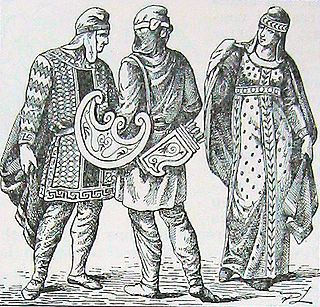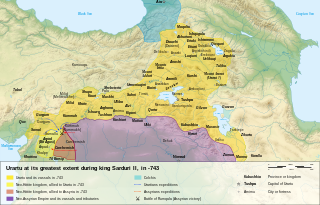
Armenian is an Indo-European language and the sole member of an independent branch of that language family. It is the native language of the Armenian people and the official language of Armenia. Historically spoken in the Armenian highlands, today Armenian is widely spoken throughout the Armenian diaspora. Armenian is written in its own writing system, the Armenian alphabet, introduced in 405 AD by the canonized saint Mesrop Mashtots. The estimated number of Armenian speakers worldwide is between five and seven million.

Armenians are an ethnic group and nation native to the Armenian highlands of West Asia. Armenians constitute the main population of the Republic of Armenia and constituted the main population of the unrecognized Republic of Artsakh until the flight of Armenians from Nagorno-Karabakh. There is a wide-ranging diaspora of around five million people of full or partial Armenian ancestry living outside modern Armenia. The largest Armenian populations today exist in Russia, the United States, France, Georgia, Iran, Germany, Ukraine, Lebanon, Brazil, Argentina, Syria, and Turkey. The present-day Armenian diaspora was formed mainly as a result of the Armenian genocide with the exceptions of Iran, former Soviet states, and parts of the Levant.
The Hurro-Urartian languages are an extinct language family of the Ancient Near East, comprising only two known languages: Hurrian and Urartian.

The Phrygians were an ancient Indo-European speaking people who inhabited central-western Anatolia in antiquity.

The Mushki were an Iron Age people of Anatolia who appear in sources from Assyria but not from the Hittites. Several authors have connected them with the Moschoi (Μόσχοι) of Greek sources and the Georgian tribe of the Meskhi. Josephus Flavius identified the Moschoi with the Biblical Meshech. Two different groups are called Muški in Assyrian sources, one from the 12th to the 9th centuries BC near the confluence of the Arsanias and the Euphrates and the other from the 8th to the 7th centuries BC in Cappadocia and Cilicia. Assyrian sources clearly identify the Western Mushki with the Phrygians, but later Greek sources then distinguish between the Phrygians and the Moschoi.
Moschia is a mountainous region of Georgia between Iberia, Armenia, and Colchis. The Moschian Mountains were the connecting chain between the Caucasus and Anti-Taurus Mountains. The people of that area were known as the Moschi. They may have been connected to the Mushki.

Graeco-Aryan, or Graeco-Armeno-Aryan, is a hypothetical clade within the Indo-European family that would be the ancestor of Hellenic, Armenian, and the Indo-Iranian languages, which spans Southern Europe, Armenian highlands and Southern Asian regions of Eurasia.

Paeonian, sometimes spelled Paionian, is a poorly attested, extinct language spoken by the ancient Paeonians until late antiquity.

Armenian mythology originated in ancient Indo-European traditions, specifically Proto-Armenian, and gradually incorporated Hurro-Urartian, Mesopotamian, Iranian, and Greek beliefs and deities.
Graeco-Armenian is the hypothetical common ancestor of Greek and Armenian branches that postdates Proto-Indo-European language. Its status is somewhat similar to that of the Italo-Celtic grouping: each is widely considered plausible without being accepted as established communis opinio. The hypothetical Proto-Graeco-Armenian stage would need to date to the 3rd millennium BC and would be only barely different from either late Proto-Indo-European or Graeco-Armeno-Aryan.
The origin of the Armenians is a topic concerned with the emergence of the Armenian people and the country called Armenia. The earliest universally accepted reference to the people and the country dates back to the 6th century BC Behistun Inscription, followed by several Greek fragments and books. The earliest known reference to a geopolitical entity where Armenians originated from is dated to the 13th century BC as Uruatri in Old Assyrian. Historians and Armenologists have speculated about the earlier origin of the Armenian people, but no consensus has been achieved as of yet. Genetic studies show that Armenian people are indigenous to historical Armenia, showing little to no signs of admixture since around the 13th century BC.
The name Armenia entered English via Latin, from Ancient Greek Ἀρμενία.

Proto-Armenian is the earlier, unattested stage of the Armenian language which has been reconstructed by linguists. As Armenian is the only known language of its branch of the Indo-European languages, the comparative method cannot be used to reconstruct its earlier stages. Instead, a combination of internal and external reconstruction, by reconstructions of Proto-Indo-European and other branches, has allowed linguists to piece together the earlier history of Armenian.

In classical antiquity, Phrygia was a kingdom in the west-central part of Anatolia, in what is now Asian Turkey, centered on the Sangarios River. After its conquest, it became a region of the great empires of the time.

Urartu was an Iron Age kingdom centered around Lake Van in the Armenian Highlands. It extended from the eastern bank of the upper Euphrates River to the western shores of Lake Urmia and from the mountains of northern Iraq to the Lesser Caucasus Mountains. The kingdom emerged in the mid-9th century BC and dominated the Armenian Highlands in the 8th and 7th centuries BC. Urartu frequently warred with Assyria and became, for a time, the most powerful state in the Near East. Weakened by constant conflict, it was eventually conquered by the Iranian Medes in the early 6th century BC. Archaeologically, it is noted for its large fortresses and sophisticated metalwork. Its kings left behind cuneiform inscriptions in the Urartian language, a member of the Hurro-Urartian language family. Since its re-discovery in the 19th century, Urartu, which is commonly believed to have been at least partially Armenian-speaking, has played a significant role in Armenian nationalism.

The name Armeno-Phrygian is used for a hypothetical language branch, which would include the languages spoken by the Phrygians and the Armenians, and would be a branch of the Indo-European language family, or a sub-branch of either the proposed "Graeco-Armeno-Aryan" or "Armeno-Aryan" branches. According to this hypothesis, Proto-Armenian was a language descendant from a common ancestor with Phrygian and was closely related to it. Proto-Armenian differentiated from Phrygian by language evolution over time but also by the Hurro-Urartian language substrate influence. Classification is difficult because little is known of Phrygian, but Proto-Armenian arguably forms a subgroup with Greek and Indo-Iranian.

Paeonians were an ancient Indo-European people that dwelt in Paeonia. Paeonia was an old country whose location was to the north of Ancient Macedonia, to the south of Dardania, to the west of Thrace and to the east of Illyria, most of their land was in the Axios river basin, roughly in what is today North Macedonia.
The Urumu were a tribe attested in cuneiform sources in the Bronze Age. They are often considered to be one of the ancestors of the Armenians being one of the tribes which were part of the Armenian Hayasa-Azzi confederation.











